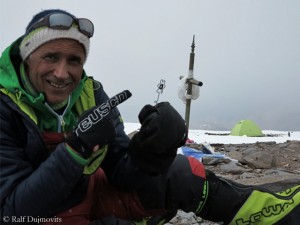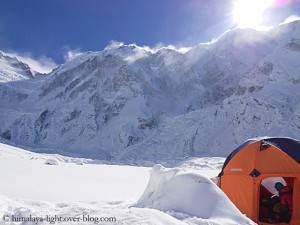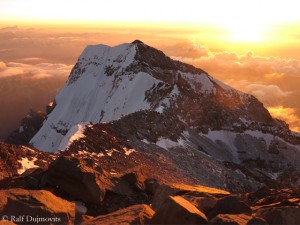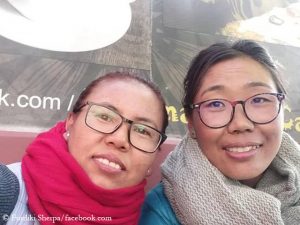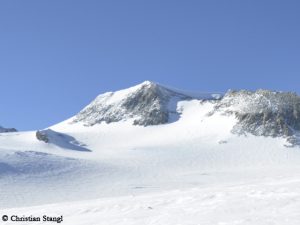Dujmovits: Solo on Nanga Parbat – above 5000 meters
Fast and alone. That is Ralf Dujmovits’ tactics for his winter ascent of Nanga Parbat. The first German, who climbed all fourteen 8000ers, has chosen an unusual way of acclimatizing: The 52-year-old climbed Aconcagua, the highest mountain of South America, and spent two nights at the 6962-meter-high summit. Ralf’s wife Gerlinde Kaltenbrunner will be missing from the expedition to Nanga Parbat. The 43-year-old female climber from Austria must cure her joints which are overstressed by training. Today Ralf travelled to Pakistan. During his brief stopover at home in the German town of Buehl I spoke to him:
Ralf, why did you choose Nanga Parbat?
Nanga Parbat is for me – and has been also for Gerlinde for a long time – the most beautiful 8000er. Whenever we were asked after having finished the fourteen 8000ers, which of them we might try again, we independently answered: Nanga Parbat .
And why in winter?
It’s natural to try something that has not yet be done successfully. Therefore it makes sense to combine the return to Nanga Parbat with a winter ascent. If you already know a climb, if you know what to expect where, how many vertical meters are still missing, which difficulties have to be overcome, it’s a mental advantage. In this case also a winter ascent is surely less difficult compared with the initial situation that you have never climbed this mountain.
But you are not known as an expert on winter climbing in the Himalayas and in Karakoram.
Certainly not, but I have a lot of experience, and I hope that I can benefit from it in this winter project. I have done not only these 14. I have returned very often without reaching the summit. I gained a lot of experience during my total of 32 expeditions to 8000ers. I dare to do this winter climb.
You want to climb up via the Diamir face, where in recent years winter expeditions have got frequently stuck in the snow. Why did you decide for this option?
Only some of the climbers got really stuck in the snow. More frequently they failed because there was too much blue ice on their routes. Denis Urubko and Simon Moro, for example, wanted to take the Kinshofer route in 2012, but saw that it was full of blue ice. I think much depend on the current conditions. I don’t want to define my route just now, I leave it open. I will take a look at the conditions on the mountain. And afterwards I will decide for one of the options.
You’ll be at the place, where terrorists shot eleven climbers last summer. Are you worried about your safety?
Not about my personal safety. Certainly it would be easier in winter to go to the Rupal side where other winter expeditions will also be now. But I do not think that such a terrible incident will happen again, that the Taliban will turn up there again. But it’s a different story to deal with the fact that I am the first expedition in this basecamp after the murder attack. I have thought about this intensively. The people living in this area need mountain tourism and expeditions. The whole Diamir valley lives to a large extent from the work as porters. If no more expeditions come, it would be a total loss of income for the villages. I just want make clear that furthermore you can go there for climbing.
You will be accompanied by Dariusz, called “Darek” Zaluski, a companion of your K-2 Expedition in 2011. Are you a rope team of two?
No, Darek will accompany me to base camp and maybe to a maximum height of 5000 meters. This is the front area with rather flatter glaciers where you have to expect many crevasses. Above 5000 meters you have steep slopes, where you also can also find crevasses, but certainly not as treacherous ones as on the flatter sections. Darek is not as acclimatized as I am after my trip to South America. For this reason I ‘m going to climb alone above 5000 meters.
That’s a very special challenge.
Yes, certainly. To handle the loneliness is a very special theme. But I want to climb in a very simple and very fast style. And the fastest way to act completely free and independently is to climb solo. I have prepared myself for this challenge. I have been alone on Aconcagua for days, and I really feel well-acclimatized. That’s why my mind is free and I think that I can handle the loneliness.
A solo project is definitely riskier than climbing in a team. How do your wife Gerlinde feel about this?
Gerlinde was not happy when I talked to her about my project. But she knows that I have this idea in my mind for such a long time. So she didn’t want to put obstacles in the path. But of course she was not quite happy.
You’ve mentioned your acclimatization on Aconcagua. This is very unusual.
I realized that many climbers of winter expeditions in past years have spent themselves by acclimatization on 8000ers. You need a lot of energy to build up high camps, to fix ropes and do other things. There are only very few, very short weather windows in winter. If you, in a way, waste them for acclimatization, you lose so much energy that you actually should save for your summit attempt. That’s why I did my acclimatization in South America, not without effort but more pleasant, less elaborate, less tough as on a 8000er. Today in the morning I placed myself on the balance. I haven’t lost a single kilo over the three and a half weeks in South America. And I’ve spent four nights in high camp at 6000 meters and two nights on the summit of Aconcagua with almost 7000 meters. I think I’m perfectly acclimatized.
What is your schedule for Nanga Parbat?
I know that in winter you can’t stand the cold and the wind on the mountain for long. So I do not plan to stay for a long time. If my meteorologist Charly Gabl from Innsbruck should predict a weather window one day after my arrival at base camp, I might actually start immediately. I would try to move very fast and to climb without high camps and fixed ropes.
And how many attempts do you plan?
One, maximum two.
P.S. I will stay in touch with Ralf in Pakistan. So you’ll get first-hand-information in my blog.



